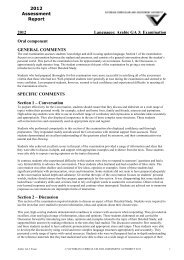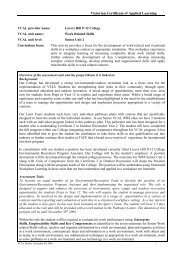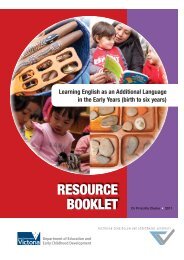television, digital media and children's learning - Victorian ...
television, digital media and children's learning - Victorian ...
television, digital media and children's learning - Victorian ...
Create successful ePaper yourself
Turn your PDF publications into a flip-book with our unique Google optimized e-Paper software.
In Howard Gardner’s terms they develop their inter- <strong>and</strong> intra-personal intelligences. Several<br />
studies have demonstrated, for example, the strong link between Sesame Street <strong>and</strong><br />
children’s readiness for kindergarten, regardless of socio-economic status, <strong>and</strong> those effects<br />
can last well into high school. In more recent years, Sesame Street has gone beyond the<br />
basics of number <strong>and</strong> the alphabet to incorporate elements of Gardner’s ‘multiple<br />
intelligences’.<br />
Children will watch good programs repeatedly, <strong>and</strong> keep watching them as they grow older,<br />
<strong>learning</strong> different things each time because they can engage with quality content in<br />
increasingly sophisticated ways. The young brain’s plasticity, its capacity to learn through<br />
repetition <strong>and</strong> reinforcement <strong>and</strong> the forging of new connections, make good <strong>media</strong><br />
experiences a potent <strong>learning</strong> <strong>and</strong> developmental tool.<br />
Play is important in children’s emotional development. A young child can try out roles not yet<br />
possible in the real world; <strong>television</strong> can exp<strong>and</strong> their world of play <strong>and</strong> take them to places<br />
they could not imagine. The 0-5 age group is moving from a self-centred view of the world to a<br />
more social outlook, so observing the experience of others in stories on <strong>television</strong> can<br />
enhance their underst<strong>and</strong>ing of their world. Preschoolers are also forming their personal<br />
style, their sense of identity within their family, in a sex role, outside the family <strong>and</strong> within an<br />
ethnic or racial group. Television programming feeds into this emerging social-self <strong>and</strong> can be<br />
used to present a wide range of role models <strong>and</strong> images that show different cultures, styles<br />
<strong>and</strong> environments.<br />
Good <strong>children's</strong> <strong>television</strong> comprises programs made especially for children that reflect the<br />
complexity of the emotional changes within the age group <strong>and</strong> honestly deal with conflicts that<br />
such diversity demonstrates. These programs can help clarify emotions, reflect anxieties <strong>and</strong><br />
hopes <strong>and</strong> recognise problems while suggesting solutions to overcome hardships <strong>and</strong> worries.<br />
In their early years preschoolers need to be hearing <strong>and</strong> seeing stories which help them work<br />
through their fears in a positive manner. They need to learn to share, to appreciate others, to<br />
know that jealousy, greed <strong>and</strong> anger are feelings we all have that we must learn to control.<br />
They are on a journey to discover how to connect emotions <strong>and</strong> motivations of characters to<br />
their actions. Zimmerman (2007) says programs such as Blue’s Clues ‘cleverly use the<br />
medium of TV to exp<strong>and</strong> not only the child’s underst<strong>and</strong>ing of, but also his or her interaction<br />
with the real world’. Television is well placed to provide such experiences.<br />
Programs such as Barney & Friends, Sesame Street, Blue’s Clues, Dora the Explorer <strong>and</strong><br />
others claim to combine more than 100 potential teaching elements <strong>and</strong> enhance children’s<br />
performance in social skills, imagination, singing <strong>and</strong> dancing through active engagement with<br />
program content. Cognitive gains include numbers, letters <strong>and</strong> vocabulary; social <strong>learning</strong><br />
such as taking turns, sharing <strong>and</strong> cooperation; physical improvements in small <strong>and</strong> large<br />
motor skills; <strong>and</strong> emotional lessons in dealing with anger, disappointment, feeling sad or<br />
happy. (Weber & Singer, 2004).<br />
Unlike some curriculum <strong>and</strong> <strong>media</strong> approaches which rigidly separate what experiences are<br />
appropriate for infants compared with toddlers <strong>and</strong> older children, the evidence is that quality<br />
TV programs <strong>and</strong> games can be designed for three to eight-year-olds <strong>and</strong> understood by them<br />
at different levels. The younger ones take in messages that match their level of cognitive<br />
development <strong>and</strong> older children interpret them at a more sophisticated level. Technology<br />
makes it possible to design programs that are not only appropriate to a particular age group,<br />
but also to different developmental levels within that age group. The computer is inherently<br />
adaptable to different <strong>learning</strong> styles, but there is as yet little evidence of that adaptability<br />
being harnessed in the cause of more individually appropriate <strong>learning</strong>.<br />
5

















